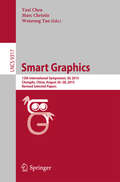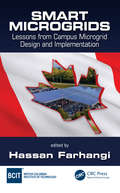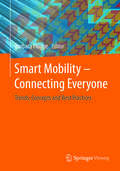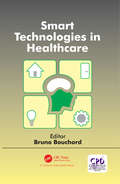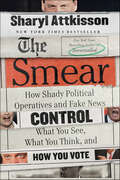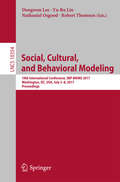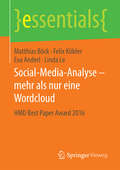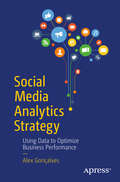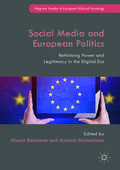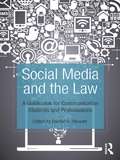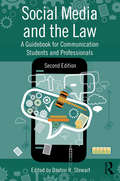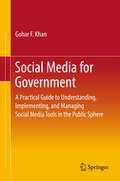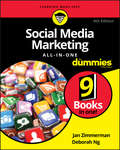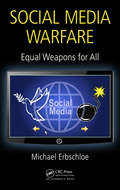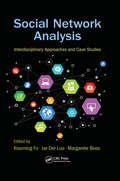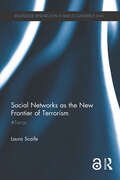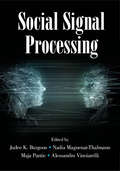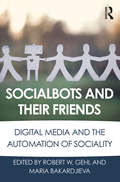- Table View
- List View
Smart Computing and Communication
by Meikang QiuThis book constitutes the proceedings of the First International Conference on Smart Computing and Communication, SmartCom 2016, held in Shenzhen, China, in December 2016. The 59 papers presented in this volume were carefully reviewed and selected from 210 submissions. The conference focuses on both smart computing and communications fields and aims to collect recent academic work to improve the research and practical applications.
Smart Energy: From Fire Making to the Post-Carbon World
by Jianping Liu Shaoqiang Chen Tao LiuSmart Energy: From Fire Making to the Post-Carbon World first traces the history of mankind's discovery and use of energy. It then reviews contemporary issues such as global warming, environmental deterioration, depletion of carbon energy sources, and energy disputes. Next, it evaluates technical innovations, system change, and international cooperation. Then, it tackles how civilization will evolve in light of meeting future energy needs, how Smart Energy will meet these needs, and defines the global mission. It ends with a summary of China’s vision of a Smart Energy future. This is required reading for everyone concerned about energy, environment, economy, human survival, and development .
Smart Graphics: 13th International Symposium, SG 2015, Chengdu, China, August 26-28, 2015, Revised Selected Papers (Lecture Notes in Computer Science #9317)
by Yaxi Chen, Marc Christie and Wenrong TanThis book constitutes the proceedings of the 13th International Symposium on Smart Graphics, SG 2015, held in Chengdu, China, in August 2015. The 17 full and 3 short papers presented in this volume were carefully reviewed and selected from 35 submissions. They are organized in topical sections named: graphics, sketching and visualization, automation and evaluation, image processing, and posters and demo session.
Smart Health
by Yong Zhang Chunxiao Xing Ye LiangThis book constitutes the thoroughly refereed post-conference proceedings of the International Conference for Smart Health, ICSH 2016, held in Haikou, Hainan, China, in December 2016. The 23 full papers presented were carefully reviewed and selected from 52 submissions. They are organized around the following topics: big data and smart health; health data analysis and management; healthcare intelligent systems and clinical practice; medical monitoring and information extraction; clinical and medical data mining.
Smart Microgrids: Lessons from Campus Microgrid Design and Implementation
by Russell L. HermanThe utility sector’s transition to renewable energy and the smart grid has already begun. The first step towards smart grid is microgrid, which is a smaller electricity grid with access to all the essential assets of a larger grid. This book provides a glimpse into an actual microgrid project. It supplies a system-level approach to the design of smart Microgrids, covering the entire design process—from roadmap to realization. Detailing lessons learned and pitfalls to avoid in Microgrid technology, the book provides an interdisciplinary approach to design and problem solving for smart microgrids.
Smart Mobility – Connecting Everyone
by Barbara FlüggeThis book presents a comprehensive overview of various aspects of mobility and transportation to be smart and seamless. It provides basic principles and trends of smart mobility as well as international examples. The topic of this work is especially interesting as the future of human centered and business triggered ecosystems is increasingly dependent on the coordination capabilities of all participating and influencing members to manage transportation needs. Even more the fulfillment of the right to mobility for individual and cargo related mobility asks for mobility enablement in a predictive, digital and intermodal manner. Therefore, this book is useful not only for decision makers in several positions but also for people who are interested in trends of transportation and mobility.
Smart Objects and Technologies for Social Good: Third Eai International Conference, Goodtechs 2017, Pisa, Italy, November 29-30, 2017, Proceedings (Lecture Notes of the Institute for Computer Sciences, Social Informatics and Telecommunications Engineering #233)
by Johann Marquez-Barja Ombretta Gaggi Carlos Calafate Laura Ricci Barbara GuidiThis book constitutes the refereed proceedings of the Third EAI International Conference on Smart Objects and Technologies for Social Good, GOODTECHS 2017, held in Pisa, Italy, November 29-30, 2017. The 38 revised full papers presented were carefully reviewed and selected from 70 submissions. The papers reflect the design, implementation, deployment, operation and evaluation of smart objects and technologies for social good. A social good can be understood as a service that benefits a large number of people in a most possible way. Some classic examples are healthcare, safety, environment, democracy, and human rights, or even art, entertainment, and communication.
Smart Technologies in Healthcare
by Bruno BouchardAssistive technologies for the old and people with disabilities is now a very active field of research. It also constitutes a very profitable market (expected to reach US $60 billion p.a. by 2018). The book covers key aspects of this important field and provides guidelines for developing assistive technologies in smart environments. The book also presents the new paradigm of open innovation used by the most prolific research teams around the world. The latest developments in the field are given. Overall this book will be a reference for researchers, practitioners and engineers.
The Smear: How Shady Political Operatives and Fake News Control What You See, What You Think, and How You Vote
by Sharyl AttkissonNew York Times BestsellerEver wonder how politics turned into a take-no-prisoners blood sport? The New York Times bestselling author of Stonewalled pulls back the curtain on the shady world of opposition research and reveals the dirty tricks those in power use to influence your opinions.Behind most major political stories in the modern era, there is an agenda; an effort by opposition researchers, spin doctors, and outside interests to destroy an idea or a person. The tactic they use is the Smear. Every day, Americans are influenced by the Smear without knowing it. Paid forces cleverly shape virtually every image you cross. Maybe you read that Donald Trump is a racist misogynist, or saw someone on the news mocking the Bernie Sanders campaign. The trick of the Smear is that it is often based on some shred of truth, but these media-driven "hit pieces" are designed to obscure the truth. Success hinges on the Smear artist’s ability to remain invisible; to make it seem as if their work is neither calculated nor scripted. It must appear to be precisely what it is not.Veteran journalist Sharyl Attkisson has witnessed this practice firsthand. After years of being pitched hit jobs and puff pieces, she’s an expert at detecting Smear campaigns. Now, the hard-hitting investigative reporter shares her inside knowledge, revealing how the Smear takes shape and who its perpetrators are—including Clinton confidant Sidney Blumenthal and, most influential of all, "right-wing assassin turned left-wing assassin" (National Review) political operative David Brock and his Media Matters for America empire.Attkisson exposes the diabolical tactics of Smear artists, and their outrageous access to the biggest names in political media—operatives who are corrupting the political process, and discouraging widespread citizen involvement in our democracy.
So Much I Want to Tell You: Letters to My Little Sister
by Anna AkanaFrom Internet sensation Anna Akana comes a candid and poignant collection of essays about love, loss, and chasing adulthood. In 2007, Anna Akana lost her teen sister, Kristina, to suicide. In the months that followed, she realized that the one thing helping her process her grief and begin to heal was comedy. So she began making YouTube videos as a form of creative expression and as a way to connect with others. Ten years later, Anna has more than a million subscribers who watch her smart, honest vlogs on her YouTube channel. Her most popular videos, including “How to Put On Your Face” and “Why Girls Should Ask Guys Out,” are comical and provocative, but they all share a deeper message: Your worth is determined by you and you alone. You must learn to love yourself. In So Much I Want to Tell You, Anna opens up about her own struggles with poor self-esteem and reveals both the highs and lows of coming-of-age. She offers fresh, funny, hard-won advice for young women on everything from self-care to money to sex, and she is refreshingly straightforward about the realities of dating, female friendship, and the hustle required to make your dreams come true. This is Anna’s story, but, as she says, it belongs just as much to Kristina and to every other girl who must learn that growing up can be hard to do. Witty and real, Anna breaks things down in a way only a big sister can.Advance praise for So Much I Want to Tell You“This book is filled with the kind of honesty, vulnerability, and determination that makes Anna such a captivating person. One warning: You’ll want to hug her a lot while reading this.”—Natalie Tran, actress and comedian “As a woman working in entertainment, Anna Akana is accustomed to feeling vulnerable. Which means that she’s used to being brave. This book is a tribute to the duality of bravery and fear as told through Anna’s experiences to date.”—Hannah Hart, New York Times bestselling author of Buffering: Unshared Tales of a Life Fully Loaded “Frank advice on how to live a productive, happy life . . . written in tribute to a ‘fearless, talented, and bold’ sister.”—Kirkus Reviews
Social, Cultural, and Behavioral Modeling: 10th International Conference, SBP-BRiMS 2017, Washington, DC, USA, July 5-8, 2017, Proceedings (Lecture Notes in Computer Science #10354)
by Dongwon Lee, Yu-Ru Lin, Nathaniel Osgood and Robert ThomsonThis book constitutes the refereed proceedings of the 10th International Conference on Social, Cultural, and Behavioral Modeling & Prediction and Behavior Representation in Modeling and Simulation, SBP-BRiMS 2017, held in Washington, DC, USA, in July 2017.The 16 full papers and 27 short papers presented were carefully reviewed and selected from 79 submissions. Owing to its strong multi-disciplinary heritage, the papers represent a large range of disciplines including computer science, psychology, sociology, communication science, public health, bioinformatics, political science, and organizational science and use numerous types of computational methods such as machine learning, language technology, social network analysis and visualization, agent-based simulation, and statistics. They are organized in the following topical sections: behavioral and social sciences; cyber and intelligence applications; information, systems, and network sciences; and methodology.
Social-Media-Analyse – mehr als nur eine Wordcloud: HMD Best Paper Award 2016 (essentials)
by Matthias Böck Felix Köbler Eva Anderl Linda LeDie Autoren legen beispielhafte Analysemethoden von Social-Media-Daten dar: deskriptive und Data-Mining-Methoden. Mit deren Hilfe werden kundenorientierte Gesch#65533;ftsma#65533;nahmen eingeleitet und ein stetiges Abw#65533;gen zwischen vollautomatisierten und manuellen, kostenintensiven Reports gesteuert. Das Werk liefert eine #65533;bersicht zu aktuell diskutierten Themen wie begleitende Emotionen, Vernetzung der interagierenden User oder Verbindung von Themen. Als Gewinn f#65533;r ein Unternehmen m#65533;ssen die Analysen durch eine strategische Prozedur geleitet werden, um Erkenntnisse in konkrete Handlungsempfehlungen zu #65533;berf#65533;hren. Neben den Potenzialen durch die Anwendung komplexerer Analysemethoden gibt es auch konzeptionelle, technische und ethische Herausforderungen, wie die Autoren veranschaulichen.
Social Media Analytics Strategy
by Alex GonçalvesThis book shows you how to use social media analytics to optimize your business performance. The tools discussed will prepare you to create and implement an effective digital marketing strategy. From understanding the data and its sources to detailed metrics, dashboards, and reports, this book is a robust tool for anyone seeking a tangible return on investment from social media and digital marketing. Social Media Analytics Strategy speaks to marketers who do not have a technical background and creates a bridge into the digital world. Comparable books are either too technical for marketers (aimed at software developers) or too basic and do not take strategy into account. They also lack an overview of the entire process around using analytics within a company project. They don’t go into the everyday details and also don’t touch upon common mistakes made by marketers. This book highlights patterns of common challenges experienced by marketers from entry level to directors and C-level executives. Social media analytics are explored and explained using real-world examples and interviews with experienced professionals and founders of social media analytics companies. What You’ll Learn Get a clear view of the available data for social media marketing and how to access all of itMake use of data and information behind social media networks to your favorKnow the details of social media analytics tools and platforms so you can use any tool in the marketApply social media analytics to many different real-world use casesObtain tips from interviews with professional marketers and founders of social media analytics platformsUnderstand where social media is heading, and what to expect in the future Who This Book Is For Marketing professionals, social media marketing specialists, analysts up to directors and C-level executives, marketing students, and teachers of social media analytics/social media marketing
Social Media and European Politics
by Asimina Michailidou Mauro BarisioneThis volume investigates the role of social media in European politics in changing the focus, frames and actors of public discourse around the EU decision-making process. Throughout the collection, the contributors test the hypothesis that the internet and social media are promoting a structural transformation of European public spheres which goes well beyond previously known processes of mediatisation of EU politics. This transformation addresses more fundamental challenges in terms of changing power relations, through processes of active citizen empowerment and exertion of digitally networked counter-power by civil society, news media, and political actors, as well as rising contestation of representative legitimacy of the EU institutions. Social Media and European Politics offers a comprehensive approach to the analysis of political agency and social media in European Union politics, by bringing together scholarly works from the fields of public sphere theory, digital media, political networks, journalism studies, euroscepticism, political activism and social movements, political parties and election campaigning, public opinion and audience studies.
Social Media and the Law: A Guidebook for Communication Students and Professionals
by Daxton R. “Chip” StewartSocial media platforms like Facebook, Twitter, Pinterest, YouTube, and Flickr allow users to connect with one another and share information with the click of a mouse or a tap on a touchscreen—and have become vital tools for professionals in the news and strategic communication fields. But as rapidly as these services have grown in popularity, their legal ramifications aren’t widely understood. To what extent do communicators put themselves at risk for defamation and privacy lawsuits when they use these tools, and what rights do communicators have when other users talk about them on social networks? How can an entity maintain control of intellectual property issues—such as posting copyrighted videos and photographs—consistent with the developing law in this area? How and when can journalists and publicists use these tools to do their jobs without endangering their employers or clients? In Social Media and the Law, eleven media law scholars address these questions and more, including current issues like copyright, online impersonation, anonymity, cyberbullying, sexting, and WikiLeaks. Students and professional communicators alike need to be aware of laws relating to defamation, privacy, intellectual property, and government regulation—and this guidebook is here to help them navigate the tricky legal terrain of social media.
Social Media and the Law: A Guidebook for Communication Students and Professionals
by Daxton StewartSocial media platforms like Facebook, Twitter, Instagram, YouTube, and Snapchat allow users to connect with one another and share information with the click of a mouse or a tap on a touchscreen—and have become vital tools for professionals in the news and strategic communication fields. But as rapidly as these services have grown in popularity, their legal ramifications aren’t widely understood. To what extent do communicators put themselves at risk for defamation and privacy lawsuits when they use these tools, and what rights do communicators have when other users talk about them on social networks? How can an entity maintain control of intellectual property issues—such as posting copyrighted videos and photographs—consistent with the developing law in this area? How and when can journalists and publicists use these tools to do their jobs without endangering their employers or clients? Including two new chapters that examine First Amendment issues and ownership of social media accounts and content,?Social Media and the Law brings together thirteen media law scholars to address these questions and more, including current issues like copyright, online impersonation, anonymity, cyberbullying, sexting, and live streaming. Students and professional communicators alike need to be aware of laws relating to defamation, privacy, intellectual property, and government regulation—and this guidebook is here to help them navigate the tricky legal terrain of social media.
Social Media for Government
by Gohar F. KhanThis book provides practical know-how on understanding, implementing, and managing main stream social media tools (e. g. , blogs and micro-blogs, social network sites, and content communities) from a public sector perspective. Through social media, government organizations can inform citizens, promote their services, seek public views and feedback, and monitor satisfaction with the services they offer so as to improve their quality. Given the exponential growth of social media in contemporary society, it has become an essential tool for communication, content sharing, and collaboration. This growth and these tools also present an unparalleled opportunity to implement a transparent, open, and collaborative government. However, many government organization, particularly those in the developing world, are still somewhat reluctant to leverage social media, as it requires significant policy and governance changes, as well as specific know-how, skills and resources to plan, implement and manage social media tools. As a result, governments around the world ignore or mishandle the opportunities and threats presented by social media. To help policy makers and governments implement a social media driven government, this book provides guidance in developing an effective social media policy and strategy. It also addresses issues such as those related to security and privacy.
Social Media Marketing: Facebook Marketing, Youtube Marketing, Instagram Marketing
by Mark SmithCreate Amazing Business Opportunities And Reach More Followers Using the Power of The Social Media! This Box Set Includes 3 Books - Facebook Marketing, Youtube Marketing, Instagram Marketing.
Social Media Marketing All-in-One For Dummies
by Deborah Ng Jan ZimmermanThe bestselling social media marketing book Marketing your business through social media isn't an option these days—it's absolutely imperative. In this new edition of the bestselling Social Media Marketing All-in-One For Dummies, you'll get comprehensive, expert guidance on how to use the latest social media platforms to promote your business, reach customers, and thrive in the global marketplace. Social media continues to evolve at breakneck speed, and with the help of this guide, you'll discover how to devise and maintain a successful social media strategy, use the latest tactics for reaching your customers, and utilize data to make adjustments to future campaigns and activities. Plus, you'll find out how to apply the marketing savvy you already have to the social media your prospects are using, helping you to reach—and keep—more customers, make more sales, and boost your bottom line. Includes the latest changes to Facebook, Twitter, Pinterest, LinkedIn, YouTube, and more Offers tips for engaging your community and measuring your efforts Explains how to blend social media with your other online and offline marketing efforts Shows you how to leverage data to learn more about your community Don't get left behind! Let this book help you get the most from every minute and dollar you spend on marketing.
Social Media Warfare: Equal Weapons for All
by Michael ErbschloeSocial media applications can be weaponized with very little skill. Social media warfare has become a burden that nation states, government agencies, and corporations need to face. To address the social media warfare threat in a reasonable manner that reduces uncertainty requires dedication and attention over a very long-term. To stay secure, they need to develop the capability to defend against social media warfare attacks. Addressing unconventional warfare strategies and tactics takes time and experience, plus planning and dedication. This book will help managers develop a sound understanding of how social media warfare can impact their nation or their organization.
Social Network Analysis: Interdisciplinary Approaches and Case Studies
by Xiaoming Fu; Jar-Der Luo; Margarete BoosThe book addresses the issue of interdisciplinary understanding of collaboration on the topic of social network studies. Researchers and practitioners from various disciplines including sociology, computer science, socio-psychology, public health, complex systems, and management science have worked largely independently, each with quite different principles, terminologies, theories. and methodologies. The book aims to fill the gap among these disciplines with a number of the latest interdisciplinary collaboration studies.
Social Networks as the New Frontier of Terrorism: #Terror (Routledge Research in Information Technology and E-Commerce Law)
by Laura ScaifeTerrorism. Why does this word grab our attention so? Propaganda machines have adopted modern technology as a means to always have their content available. Regardless of the hour or time zone, information is being shared by somebody, somewhere. Social media is a game changer influencing the way in which terror groups are changing their tactics and also how their acts of terror are perceived by the members of the public they intend to influence. This book explores how social media adoption by terrorists interacts with privacy law, freedom of expression, data protection and surveillance legislation through an exploration of the fascinating primary resources themselves, covering everything from the Snowden Leaks, the rise of ISIS to Charlie Hebdo. The book also covers lesser worn paths such as the travel guide that proudly boasts that you can get Bounty and Twix bars mid-conflict, and the best local hair salons for jihadi brides. These vignettes, amongst the many others explored in this volume bring to life the legal, policy and ethical debates considered in this volume, representing an important part in the development of understanding terrorist narratives on social media, by framing the legislative debate. This book represents an invaluable guide for lawyers, government bodies, the defence services, academics, students and businesses.
Social Networks with Rich Edge Semantics (Chapman & Hall/CRC Data Mining and Knowledge Discovery Series)
by Quan Zheng David SkillicornSocial Networks with Rich Edge Semantics introduces a new mechanism for representing social networks in which pairwise relationships can be drawn from a range of realistic possibilities, including different types of relationships, different strengths in the directions of a pair, positive and negative relationships, and relationships whose intensities change with time. For each possibility, the book shows how to model the social network using spectral embedding. It also shows how to compose the techniques so that multiple edge semantics can be modeled together, and the modeling techniques are then applied to a range of datasets. Features Introduces the reader to difficulties with current social network analysis, and the need for richer representations of relationships among nodes, including accounting for intensity, direction, type, positive/negative, and changing intensities over time Presents a novel mechanism to allow social networks with qualitatively different kinds of relationships to be described and analyzed Includes extensions to the important technique of spectral embedding, shows that they are mathematically well motivated and proves that their results are appropriate Shows how to exploit embeddings to understand structures within social networks, including subgroups, positional significance, link or edge prediction, consistency of role in different contexts, and net flow of properties through a node Illustrates the use of the approach for real-world problems for online social networks, criminal and drug smuggling networks, and networks where the nodes are themselves groups Suitable for researchers and students in social network research, data science, statistical learning, and related areas, this book will help to provide a deeper understanding of real-world social networks.
Social Signal Processing
by Nadia Magnenat-Thalmann Judee K. Burgoon Alessandro Vinciarelli Maja Pantic"Social Signal Processing is the first book to cover all aspects of the modeling, automated detection, analysis, and synthesis of nonverbal behavior in human-human and human-machine interactions. Authoritative surveys address conceptual foundations, machine analysis and synthesis of social signal processing, and applications. Foundational topics include affect perception and interpersonal coordination in communication; later chapters cover technologies for automatic detection and understanding such as computational paralinguistics and facial expression analysis and for the generation of artificial social signals such as social robots and artificial agents. The final section covers a broad spectrum of applications based on social signal processing in healthcare, deception detection, and digital cities, including detection of developmental diseases and analysis of small groups. Each chapter offers a basic introduction to its topic, accessible to students and other newcomers, and then outlines challenges and future perspectives for the benefit of experienced researchers and practitioners in the field"--
Socialbots and Their Friends: Digital Media and the Automation of Sociality
by Robert W. Gehl Maria BakardjievaMany users of the Internet are aware of bots: automated programs that work behind the scenes to come up with search suggestions, check the weather, filter emails, or clean up Wikipedia entries. More recently, a new software robot has been making its presence felt in social media sites such as Facebook and Twitter – the socialbot. However, unlike other bots, socialbots are built to appear human. While a weatherbot will tell you if it's sunny and a spambot will incessantly peddle Viagra, socialbots will ask you questions, have conversations, like your posts, retweet you, and become your friend. All the while, if they're well-programmed, you won't know that you're tweeting and friending with a robot. Who benefits from the use of software robots? Who loses? Does a bot deserve rights? Who pulls the strings of these bots? Who has the right to know what about them? What does it mean to be intelligent? What does it mean to be a friend? Socialbots and Their Friends: Digital Media and the Automation of Sociality is one of the first academic collections to critically consider the socialbot and tackle these pressing questions.


